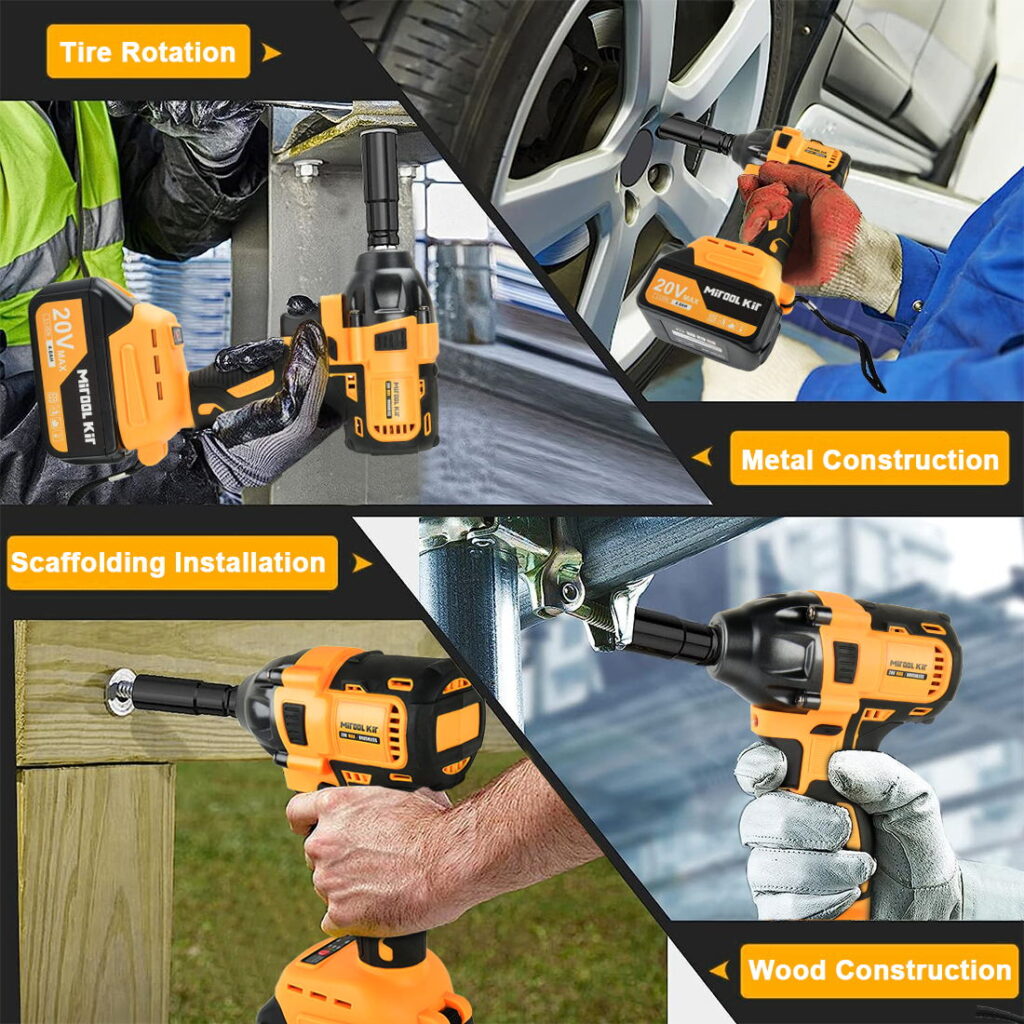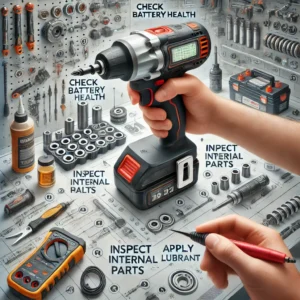When you’re in the market for a high-performance cordless impact wrench, one term that often pops up is the IPM rating. But how crucial is the IPM rating in making your decision? As a manufacturer of cordless electric wrenches in China, let me guide you through the importance of IPM and why it should be on your radar when selecting the perfect tool.
What Does IPM Stand For?
IPM stands for Impacts Per Minute. It’s a measurement that refers to how many hammer strikes the impact wrench delivers in one minute. Typically, For impact tools like impact drivers or wrenches, this feature is critical because it contributes to how quickly and effectively the tool can drive fasteners or bolts. The higher the IPM, the more frequently the tool delivers force to the task, helping speed up the process when driving screws or nuts into tough materials.
In simpler terms, IPM ratings directly affect the tool’s efficiency and performance. if you’re dealing with stubborn bolts, a higher IPM means you’ll have a better chance of loosening them quickly.
The Connection Between IPM and Torque
The IPM rating doesn’t work in isolation. It often correlates with torque. Torque refers to the rotational force that the tool applies to turn objects such as bolts, nuts, or screws. Measured in Newton-meters (Nm) or inch-pounds (in-lbs), torque determines how much twisting force is applied to a fastener.when torque and IPM combine, they offer a clearer picture of how fast and how powerful your tool is going to be.
Here’s how:
- Higher Torque = Greater Force
- Torque delivers the raw power necessary to turn fasteners. The greater the torque, the easier it becomes to drive screws or bolts into tough surfaces. However, without IPM, the application of this force would be slow and inefficient.
- Higher IPM = Faster Fastening
- IPM complements torque by determining how rapidly the impacts occur. Tools with high IPM are especially useful when speed is crucial, allowing fasteners to be driven more quickly. A tool with high IPM but insufficient torque may work fast but struggle with tougher tasks, whereas high torque with low IPM might be powerful but slow.
- Efficiency and Precision
- The interplay of torque and IPM ensures that tasks are not only done quickly but also efficiently. High torque prevents the tool from bogging down in difficult materials, while IPM ensures it delivers multiple rapid strikes to keep things moving. This balance allows for better precision, preventing overtightening or stripping fasteners.
- IPM for Tougher Materials
- When working with harder materials like concrete, steel, or thick wood, both high IPM and torque are needed. The constant impact delivered by IPM helps break through resistance, while torque supplies the power to keep the fastener driving in.

Selecting the Right Balance
When choosing an impact tool, it’s essential to balance IPM and torque depending on the tasks you intend to perform:
- High-Torque, Lower IPM: Best for tasks requiring maximum force, such as heavy-duty bolts or fasteners in metalworking and automotive industries.
- High IPM, Moderate Torque: Ideal for fast-paced work where speed is critical, such as woodwork or small-to-medium fasteners.
- High IPM, High Torque: Provides the best of both worlds, suitable for the most demanding tasks, such as industrial applications or large construction projects.
IPM and torque are essential factors in determining the efficiency and performance of impact tools. While torque provides the muscle, IPM ensures speed and consistency. Understanding the connection between these two metrics will help you select the right tool for your specific needs, ensuring better results, whether you’re working on light construction or heavy-duty industrial projects. Below table for your review.
| Task Type | Recommended IPM | Recommended Torque | Why |
|---|---|---|---|
| Light-duty tasks (small bolts, screws) | High IPM (e.g., 3000+) | Low Torque (e.g., 100-200 ft-lbs) | Quick fastening/removal without over-tightening. |
| Medium-duty tasks (car tire changes) | Medium IPM (e.g., 2000-2500) | Medium Torque (e.g., 300-500 ft-lbs) | Balanced performance for most vehicle maintenance tasks. |
| Heavy-duty tasks (rusted bolts, large fasteners) | Low IPM (e.g., 1500) | High Torque (e.g., 600+ ft-lbs) | Maximum torque for loosening tough bolts, even at lower speed. |
IPM and Application: Why the Right Rating Matters
Impact wrenches are versatile tools, but not every model is built for the same task. Take automotive repair, for instance. A cordless impact wrench with an IPM of around 3,200 would likely be a better fit for a fast-paced, high-torque application like loosening lug nuts on a truck tire.
For lighter tasks, such as assembling furniture or working in confined spaces, a tool with an IPM of 2,000–2,500 might be more appropriate. Higher IPM doesn’t always mean better, especially if you are doing fine, precision work. At Autojare, we always recommend matching the IPM to the application to avoid overworking the tool or, worse, damaging your workpiece.
Here’s a table explaining the relationship between IPM and application:
| Application | Recommended IPM | Why the Right Rating Matters | Example Tools/Tasks |
|---|---|---|---|
| Light-duty tasks (e.g., assembling furniture, working on electronics, small bolts) | 3000+ IPM | A higher IPM allows you to quickly fasten or loosen small bolts, screws, or soft materials. For light-duty work, you need speed more than power to avoid over-tightening or damaging parts. | Fastening screws on cabinets, light construction work, small bolt removal. |
| Medium-duty tasks (e.g., car tire changes, general maintenance)** | 2000-2500 IPM | For general automotive work or mid-level fasteners, a medium IPM strikes a good balance between speed and control. This ensures the wrench works fast without risking damage to parts. | Removing car tires, performing engine repairs, tightening medium bolts. |
| Heavy-duty tasks (e.g., removing rusted or large bolts, industrial use)** | 1500-2000 IPM | Lower IPM is preferable for heavy-duty applications because it provides more control and applies strong impacts over a longer time period, allowing you to break free stuck bolts or work with high-torque applications. | Loosening rusted, large fasteners, working with heavy industrial machinery. |
Why IPM Matters for Your Budget
One thing I’ve noticed in my conversations with buyers that many expect high IPM ratings to come with a higher price tag. This is often true but not always. While there’s a correlation between IPM and cost, the materials, battery life, and brand also contribute to the overall price.
At Autojare, we’ve found that by focusing on both the IPM and torque balance, we can offer tools with a strong performance-to-price ratio. Our cordless impact wrenches, for instance, range from 2,500 IPM to 3,200 IPM, giving buyers flexibility based on their needs and budget.
How to Choose the Right IPM for Your Needs
Selecting the right IPM for your needs boils down to two things: application and long-term durability. Here are a few questions you should ask yourself when making a choice:
- What will you be using the wrench for? Higher IPM tools are better for heavy-duty work, while lower IPM might suffice for more delicate tasks.
- How often will you be using the tool? If you’re in an industry that requires heavy, consistent usage, a high-IPM tool will save you time and extend the lifespan of your tool, as the impacts are better distributed.
For professionals, who represent large supermarket chains and brand retailers, these considerations are crucial. Choosing the right IPM rating can prevent delivery issues, lower long-term maintenance costs, and improve overall job satisfaction.

The Future of IPM and Impact Wrenches
At Autojare, the future of IPM in impact wrenches will focus on smarter, customizable tools. Users will be able to adjust IPM settings for different tasks, while sensors will automatically adapt speed and power based on the job. This will improve both efficiency and precision.
Energy-saving features and advanced power systems will extend battery life, making cordless models more durable. Increased precision will also enhance safety, preventing over-tightening and fastener damage, ensuring impact wrenches are more versatile and reliable in various industries.
Conclusion: The Role of IPM in Your Decision
In the end, the IPM rating is a crucial factor in determining the efficiency of your cordless impact wrench. Whether you’re in automotive repair, construction, or industrial assembly, choosing the right IPM can mean the difference between completing a job in minutes or hours.
For buyers , who prioritize quality, delivery, and service, knowing how IPM correlates with torque and overall performance is essential. At Autojare, we focus on offering high-IPM impact wrenches that not only deliver top-tier performance but also ensure long-term reliability and fast shipping times.
Choosing the right tool is a balance of numbers and application, and the IPM rating should always be a part of that equation.



